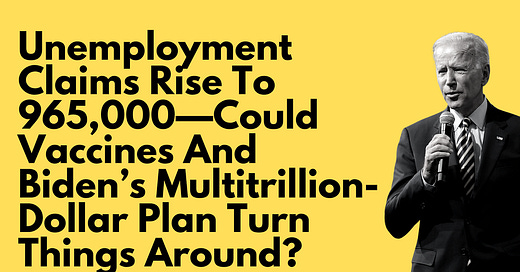U.S. Unemployment Claims Rise To 965,000—Could Vaccines And Joe Biden’s Multitrillion-Dollar Plan Turn Things Around?
It’s starting to sound like a broken record, playing the same old song over and over again. Due in large part to the continued resurgence of Covid-19 and the accompanying lockdowns and restrictions, the United States Department of Labor reported 965,000 Americans filed for unemployment benefits last week—a 23% increase from the prior week. The claims hit a five-month high. Roughly over 74 million Americans have filed for unemployment benefits since the onset of the pandemic in March 2020.
The disappointing data is disturbingly higher than the 800,000 claims that were anticipated by economists, in a survey conducted by Bloomberg. The last jobs report for 2020 showed employment falling by 140,000 in December. These numbers were significantly lower than the April pandemic highs, but about twice their pre-pandemic levels. The December jobs report signaled the end of seven months of steady job growth and evidenced that the U.S. economy is softening. Roughly 22 million jobs were lost back in March and April and a little more than half—12 million—have since been recovered.
According to MarketWatch, “Economists estimate true unemployment is several points higher because the official jobless rate doesn’t include several million people who’ve left the labor force,” as they were not able to find appropriate opportunities.” There were high hopes that the job market would pick up, but it hasn’t. Instead, the job losses are a grim reminder that the Covid-19 pandemic is in control of the health of the economy and job market.
AnnElizabeth Konkel, economist at Indeed Hiring Lab, claimed, “The race between vaccine distribution and mounting labor market damage continues.” Konkel predicted, “Even once vaccine distribution starts making a real dent in case numbers, it will still be a long road to a full economic recovery. Spring weather conditions will hopefully be a boost, allowing businesses and restaurants to again operate outdoors more easily.”
The Wall Street Journal bluntly reported, “The number of help-wanted ads increased more slowly in December, evidence the labor market is losing momentum amid rising coronavirus cases.” Indeed, the job aggregation site, wrote on its blog, “The trend in job postings was 10.6% lower than in 2019 as of Dec. 31, as slow improvement continued.” The data from Indeed reflects that there was some optimism evidenced by increased job postings, but it soon faded when the disease raged again and business closures, curfews and restrictions were announced. With fewer jobs available, the big issue is how we can get people back to work.
The majority of U.S. states posted increases in new claims—reflecting that the job losses are felt across the nation. Nancy Vanden Houten, lead U.S. economist at Oxford Economics, said about the report, “While prospects for the economy later in 2021 are upbeat, the labor market recovery has taken a step backward and we expect claims to remain elevated with the risk that they rise from last week’s levels.” Bloomberg economist Eliza Winger added, “Deterioration may still lie ahead as new virus infections surge and restrictions show no sign of abating.”
In usual fashion, the futures markets indicated a higher opening for the stock market on Thursday. This indicates the large continued disconnect between Wall Street and Main Street. Part of the reason for the uptick in stock prices is that President-elect Joe Biden is said to announce an over $1 trillion stimulus package Thursday. According to the Wall Street Journal, Biden said the previous $900 billion relief was only a “down payment” on what’s required to turn things around and the amount will “be in the trillions of dollars.”
If the money is spent wisely, such as building America’s infrastructure, which is a big part of Biden’s “Build Back Better” program, it could serve to create a significant amount of jobs. This program, along with the distribution of vaccines and quickly inoculating people, could help turn the corner.
The mood of the nation would shift from fearful to hopeful. We would start reopening businesses and schools. People could live their lives again. The momentum would feed on itself and usher in a new wave of hiring and the creation of new jobs. When this happens, the wide disconnect between the stock market and the average American will get smaller. As the economy picks up steam, everyone will start benefiting.



